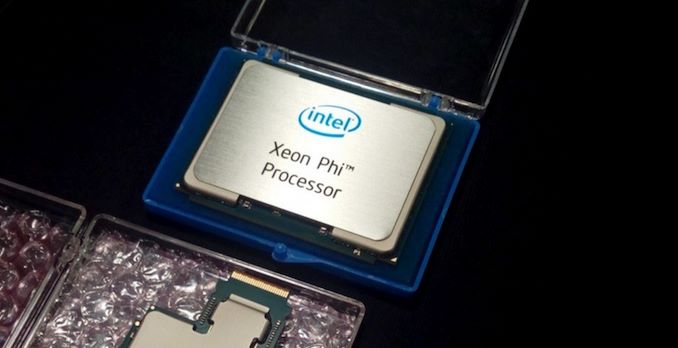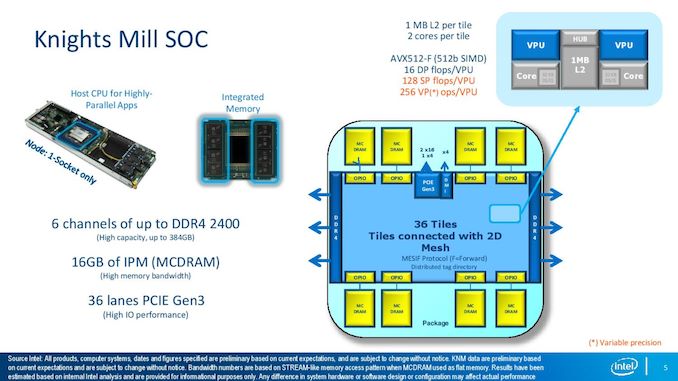The Larrabee Chapter Closes: Intel's Final Xeon Phi Processors Now in EOL
by Ian Cutress & Anton Shilov on May 7, 2019 2:15 PM EST- Posted in
- CPUs
- Intel
- Enterprise
- MIC
- Xeon Phi
- Servers
- Knights Mill

Intel this week initiated its product discontinuance plan for its remaining Xeon Phi 7200-series processors codenamed Knights Mill (KML), bringing an end to the family of processors that have now been superceded by the likes of Intel's 56-core Xeon Platinum 9200 family. Xeon Phi parts have been used primarily by supercomputers during its lifetime.
Customers interested in final Intel Xeon Phi 7295, 7285 and 7235 processors will have to place their final orders on these devices by August 9, 2019. Intel will ship the final Xeon Phi CPUs by July 31, 2020. Intel’s Knights Mill processors feature 64, 68, or 72 upgraded Silvermont x86 cores paired with AVX-512 units and MCDRAM. The parts were essentially Knights Landing parts optimized for Deep Learning applications.
Intel launched several generations of Xeon Phi over the years, including Knights Ferry, Knights Corner, Knights Landing, Knights Hill (never released), and Knights Mill. The product started off as the Larrabee project, aimed at designing a general purpose x86 compute graphics solution for Intel. We had a first glimpse of the initial architecture way back in 2008, however the graphics part of the project was killed by mid 2010, and the product lived on as a many-core processor with large vector compute units.
- April 2007: Intel Developer Forum - Beijing 2007: Penryn and Intel's High End GPU
- March 2008: Opening the Kimono: Intel Details Nehalem and Tempts with Larrabee
- August 2008: Intel's Larrabee Architecture Disclosure: A Calculated First Move
- September 2009: IDF 2009 - World's First Larrabee Demo
- December 2009: Intel Cancels Larrabee Retail Products, Larrabee Project Lives On
- May 2010: Intel Kills Larrabee GPU, Will Not Bring a Discrete Graphics Product to Market
- June 2010: Intel MIC: 22nm, 50+ Cores, Larrabee for HPC Announced
In 2016, one of the original developers of Larrabee, Tom Forsyth, wrote an piece detailing the project, some of its goals, and how far the part had been developed with graphics in mind, before being released as a many-core processor. Here's a quote, and it's well worth a read.
From Tom Forsyth: Why Didn't Larrabee Fail?
PRIMARY GOAL: VIRTUAL SUCCESS! It would have been a real success if it had ever shipped. Larrabee ran Compute Shaders and OpenCL very well - in many cases better (in flops/watt) than rival GPUs, and because it ran the other graphical bits of DirectX and OpenGL pretty well, if you were using graphics APIs mainly for compute, it was a compelling package. Unfortunately when the "we don't do graphics anymore" orders came down from on high, all that got thrown in the trash with the rest. It did also kickstart the development of a host of GPGPU-like programming models such as ISPC and CILK Plus, and those survive and are doing well.
| AVX-512 Support Propogation by Various Intel CPUs Newer uArch supports older uArch |
||||||
| Xeon | General | Xeon Phi | ||||
| Skylake-SP | AVX512BW AVX512DQ AVX512VL |
AVX512F AVX512CD |
AVX512ER AVX512PF |
Knights Landing | ||
| Cannon Lake | AVX512VBMI AVX512IFMA |
AVX512_4FMAPS AVX512_4VNNIW |
Knights Mill | |||
| Cascade Lake-SP | AVX512_VNNI | |||||
| Cooper Lake | AVX512_BF16 | |||||
| Ice Lake | AVX512_VNNI AVX512_VBMI2 AVX512_BITALG AVX512+VAES AVX512+GFNI AVX512+VPCLMULQDQ (not BF16) |
AVX512_VPOPCNTDQ | ||||
| Source: Intel Architecture Instruction Set Extensions and Future Features Programming Reference (pages 16) | ||||||
As for the Xeon Phi family, Knights Mill was the last product. Last year Intel discontinued its Xeon Phi 7210, 7210F, 7230, 7230F, 7250, 7250F, 7290, and 7290F processors, known as Knights Landing. The final shipments of Knights Landing for old systems will be made by July 19, 2019, with Knights Mill on July 31, 2020.
Related Reading
- Intel Begins EOL Plan for Xeon Phi 7200-Series ‘Knights Landing’ Host Processors
- Intel Discontinues Xeon Phi 7200-Series ‘Knights Landing’ Coprocessor Cards
- Intel’s "Knights Landing" Xeon Phi Coprocessor Detailed
- Intel @ SC15: Launching Xeon Phi “Knights Landing” & Omni-Path Architecture
- SuperComputing 15: Intel’s Knights Landing / Xeon Phi Silicon on Display
- Intel Lists Knights Mill Xeon Phi on ARK: Up to 72 cores at 320W with QFMA and VNNI
- Intel Announces Knights Mill: A Xeon Phi For Deep Learning
Source: Intel











22 Comments
View All Comments
drexnx - Tuesday, May 7, 2019 - link
that blog was definitely well worth a read, because it looks like 3 years later they've done a 180 and now graphics is a target againHStewart - Tuesday, May 7, 2019 - link
It funny that Larabee came out according to that list when I got built a Supermiro Dual Xeon 5160 machine and I place NVidia graphics in it. And I never heard of Larabee, it obvious was an experiment that went no where.Thinks are total change now with Intel Xe is totally a different type machine, I don't believe Phi was intended a graphic processor - only thing I can remember it has a Many CPU machine - a board that had many little cpu's instead of larger cpu.
One thing I am curious about is the x200 series are mark as discontinue but not 72x5 series.
I don't see Intel continuing since they will have in next year or two Xe processors.
Ian Cutress - Wednesday, May 8, 2019 - link
Larrabee was never launched as a consumer GPU. It went somewhere, just not as graphics. It ended up as Xeon Phi.SanX - Tuesday, May 7, 2019 - link
Looks like Xeon Phi was not generating Intel way too outrageous profits so they moved to something else.Can anyone show any supercomputer benchmarks of KNL versus those 56 core Xeons on molecular dynamics and PIC codes? On KNL versus previous gen Xeons the difference in PIC codes we checked was just within 20% and i doubt it will be way higher with these new incarnations of Xeons as supercomputer performance is often just memory bandwidth bound not processors performance bound.
So, OK, intel, do discontinue KNL and do not forget to decrease 10x-100x its price tag so that we will be able to have our own personal home supercomputers. The only reason we do not have ones already is Intel's monopoly with processor prices an order or more higher than the production cost.
AshlayW - Tuesday, May 7, 2019 - link
That's just intel in a nutshell: stagnate innovation and advancement of consumer technology to maximise profits and please the shareholders.CiccioB - Wednesday, May 8, 2019 - link
Ermmm.. that's what all companies do. Intel, AMD, nvidia, Qualcomm, Apple whoever, they exists to create profits for their shareholders.The way they do it is a not-caring things for them and each one follows what they think its the best path for that. Who leads try to get the maximum from what it already has, who follows try any maneuver to overtake it. Which include targeting only most profitable markets and selling at lower prices to the level of gaining anything (or loosing money) for years making the false impression they care about prices: they just are applying the best margins they can, as the leader. The difference is only on the magnitude.
Metroid - Wednesday, May 8, 2019 - link
I wonder what would happen if Intel had no money like AMD has been for some years. The money Intel has gives them the ability to fail but not for long.CiccioB - Wednesday, May 8, 2019 - link
With less money they would do as any other company in the same situation: focusing on the main business avoiding spending in other things and trying to create a single product that can bring them out of that status.Innovation would be done only on a specific segment sacrificing other technological opportunities.
A.k.a.n.e - Wednesday, May 8, 2019 - link
The table is not correct. Core i3-8121U supports AVX512-{F,CD,BW,DQ,VL,IFMA,VBMI} (see e.g. http://instlatx64.atw.hu/ ) though it's Core i3, so Cannon Lake may support AVX512-{BW,DQ,VL,IFMA,VBMI} on general (non-Xeon) ones. Also, Intel is not saying whether general Ice Lake supports AVX512-{BW,DQ,VL,VNNI,VBMI,...}. This is also the same for AVX512-BF16 of Cooper Lake.mode_13h - Thursday, May 9, 2019 - link
I guess nobody can claim Intel didn't try pushing x86 absolutely everywhere. All the way from IoT (via Edison) to GPUs (i.e. original Larrabee), phones, and HPC.I guess it had to learn the hard way that not everything is a nail you can just bash with an x86-based hammer.